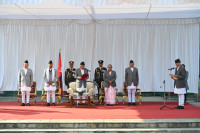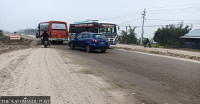National
MCC-funded power lines could hit land hurdle
Around 45 percent of the 315-km transmission line will use private land.
Prithvi Man Shrestha
Even though the US Millennium Challenge Corporation (MCC) compact overcame its biggest hurdle with its ratification by Nepal’s Parliament in February last year, concerns over the project’s implementation continue to grow, given the problems associated with land acquisition in similar other projects.
The political opposition to the US compact has not gone away and land acquisition and right of way for its transmission line project could emerge as a major challenge.
Land acquisition for transmission lines has become challenging amid recent protests by the locals of Lapsephedi in Shankharapur Municipality-3 against the Nepal Electricity Authority’s (NEA) plan to build a sub-station there.
Even though the NEA had already arranged the land to build a substation for the 400kV Khimti-Barhabise-Lapsephedi transmission line in 2018 and paid compensation to almost all those affected, locals have started a new protest against the substation plan.
“We are aware of the challenges the NEA is facing in implementing transmission line projects due to problems related to land acquisition and demands by locals to realign power lines,” said Khadga Bahadur Bisht, executive director of the Millennium Challenge Accounts-Nepal (MCA-Nepal), a special purpose vehicle established to implement the projects under the MCC-Compact.
Under the US aid programme, the MCA-Nepal will build 315-km double circuit 400kV transmission lines and three new substations. Likewise, the 77-km road section of the East-West Highway in Dang will be upgraded with new technology.
The MCC will provide a grant of $500 million and Nepal will contribute $130 million for the $630 million programme; of the sum, $500 million will be spent on the energy sector and $130 million on roads.
Around 45 percent of the 315-km transmission line will pass through privately-owned lands and the rest will go through forestlands. Acquiring private land has often been the biggest challenge for transmission line projects in Nepal.
However, the MCA-Nepal hopes it will not face serious hurdles. “The majority of the private lands through which the transmission lines will pass are in the hilly region and are not cultivated,” said Bisht. “So taking the transmission lines over such lands won’t be so difficult.”
He, however, admitted that land acquisition could be challenging in urban and suburban areas as some sections of the transmission lines would pass through populated places.
For example, the NEA has been unable to complete the Bharatpur-Bardaghat transmission line project as residents of Dumikas in Nawalparasi (East of Susta) have been obstructing the construction of two remaining pylons for over two years now.
With the MCC Compact expected to enter into force in August this year, the MCA-Nepal considers the next six-month period as significant.
In this period, the MCA-Nepal plans complete land acquisitions, forest census (for forest clearance), and selection of contractors for the construction of transmission lines, substations and road maintenance.
The MCA-Nepal on November 28 last year had issued a tender to hire contractors for the proposed 315-km power lines under three packages.
Under the first package, a contractor will be hired for the Lapsephedi-Ratamate-New Hetauda 400kV D/C Transmission Line while Ratmate-New Damauli 400kV D/C Transmission Line falls under the second package.
Similarly, the New Damauli-New Butwal 400kV D/C Transmission Line and New Butwal -Nepal/India Border 400kV D/C Transmission Line fall under the third package.
The estimated cost for all three packages is $200 million, according to the MCA-Nepal. The MCA-Nepal has also invited bids for consultants, who will oversee the construction of transmission lines, which will have a total of 850 pylons along the 315-km length. The process of land acquisition for the pylons has begun.
“After the compact’s entry into force, the projects should be completed in five years as there is no provision of time and cost extensions,” said Bisht.
However, most of Nepal’s transmission line projects witness time and cost overruns owing to difficulties in acquiring lands, getting the right of way and timely forest clearance. (The right of way refers to a strip of land over which a transmission line passes.)
“As the nature of the work on the transmission lines to be built by the MCA-Nepal and us is similar, I think the challenges are also similar,” said Dirghayu Kumar Shrestha, chief of the transmission directorate at the NEA.
The NEA has been facing bigger problems in ensuring the right of way for its transmission line projects than in acquiring lands.
The authority has been purchasing the land occupied by pylons and paying around 20 percent of the market price of the land for the right of way.
As the land along the right of way cannot be used for commercial purposes and banks also don’t accept such land as collateral, the NEA has been struggling to convince land owners to allow transmission lines to pass over their lands.
Bisht also views these as big challenges and calls for an amicable solution. “One way could be paying higher compensation for the land,” he said. “Another way could be allowing landowners to split their plots and register the land under the transmission line as separate tracts at the land revenue office, so that there will be no legal hurdle to use the land beyond the right of way for commercial purposes.”
The NEA officials, however, are worried that if the MCA-Nepal pays more in compensation for the land under right of way, it would set a bad precedent and affect the authority’s other projects. “If they paid more now, it would be difficult for the NEA to implement other transmission line projects in the future,” said Shrestha.




 10.12°C Kathmandu
10.12°C Kathmandu















